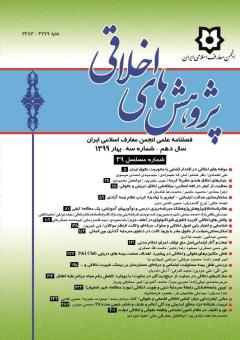بنیانهای اخلاق هندو: نظریة کرمه
محورهای موضوعی : اخلاق و تربیت اسلامیحبیب بشیرپور 1 , ابوالفضل محمودی 2
1 - دکترای ادیان و عرفان تطبیقی
2 - دانشگاه آزاد واحد علوم و تحقیقات
کلید واژه: کرمه, عمل, معرفت, تولد مجدد, سمساره,
چکیده مقاله :
کیفیت زندگی آدمی در طول دوران حیات خویش در این جهان و در سرای باقی همواره تحت تاثیر اعمال و کردار و گفتار خویش است. کرمه به معنای عمل کردن است و ثمرة عملی که تحت تأثیر خواستهها و غرائز انسانی انجام شود، در چرخة زندگیهای بعدی یا در سمساره نتیجه میدهد. با درک کرمه در اخلاق هند، میتوان وضعیت زمان حال فرد را توجیه کرد و نیز از تولدهای بعدی در آینده جلوگیری بعمل آورد. به منظور کسب کرمة خوب باید از دهرمه پیروی کرد و دستیابی به معرفت، باعث از بین رفتن کرمه میشود. به استثناء چارواکه، تمام نظامهای هندی با نظریة کرمه، کم و بیش توافق دارند. همه چیز تحت سیطرة قانون کرمه است؛ اما این قانون در نزد سانکهیه و میمانسا مستقل از ارادة الهی است و در ادیان بودایی و جین، خدایان هم تحت تأثیر قانون کرمه هستند
The quality of human life during this time of his life in this world and in the end is always influenced by your deeds and deeds and speeches. Karma means to act and the result of act that is influenced by human wants and instincts is seen in later life. By understanding Karma, one can justify the present situation and prevent future births in the future. In order to get a good karma, you have to follow Dharma and gaining knowledge leads to the destruction of the karma. With the exception of Cārvāka, all Hindu systems agree more or less with Karma's theory. Everything is under the control of the Karmic law but this law is independent of divine will in sāṃkhya and Mīmāṃsā, and in the Buddhist and Jain religions, the gods are also influenced by the law of karma
رادها كريشنان، سروپالي، (1382)، شيوۀ زندگي هندو، مترجم: سيدرضا حسيني آهي دشتي، تهران، نشر ماکان.
شايگان، داريوش، ( 1386)، اديان و مكتب هاي فلسفي هند، تهران، نشرامیرکبیر، ج 1،2.
چاترچي و موهان داتا، ساتيس چاندرا و دريندرا، ( 1384)، معرفي مكتب هاي فلسفي هند، ترجمه فرناز ناظرزاده كرماني، قم، دانشگاه ادیان و مذاهب.
BRAHMA SUTRAS, (2008), Sri Swami Sivananda(trans.), India, THE DIVINE LIFE SOCIETY.
Dasgupta, Surendranath, (1922), A HISTORY OF INDIAN PHILOSOPHY, New York, Cambridge University Press, vol. 1.
Firth, Shirley, (1977), Dying, Death and Bereavement in a British Hindu Community, Leuven, Peeters Publishers.
Gaia, Susan, (2011),” Exploring Traditions of Faith through Primary Sources”, MILESTONE DOCUMENTS OF WORLD RELIGIONS, (ed) David M. Fahey, U.S. A, Salem Press, vol. 1.
Hamilton, Sue, (2001), A Very Short Introduction INDIAN PHILOSOPHY, Newyork, Oxford University Press.
6. Halbfass, Wilhelms, (2000), Karma und Wiedergeburt im Indischen Denken, Munchen, Germany, Hugndubel.
7. Holdrege, Barbara A., (2005),” Dharma”, The HINDU WORLD, (ed) Sushil Mittal & Gene R. Thurs, USA & Canada, Routledge.
8. Jacobsen, Knut A., (2011),” Samkhya-Yoga Traditions”, THE CONTINUM CAMPANION TO HINDU STUDES, (ed) Jessica Frazier, London And New York, Continuum.
9. J. Jolly, (1912),” ETHIC AND MORTALITY”, Encyclopedia of ReligionA and Ethics, (ed) James Hasting, New York, Edinburgh: T. & T. Clark, vol. 5.
10. Klosternaier, Klaus K., (2005),” Moksa”, The HINDU WORLD, (ed) Sushil Mittal & Gene R. Thursby, U.S.A, Canada, Routledge.
11. Krishnan, Yuvraj, (1997), The Doctrine of Karma, Delhi, Motilal Banarsidass Publishers.
12. Lipner, Julius, (2010),” Karman”, Brill’s Encyclopedia of Hinduism, (ed) Knut A. jacobsen, Leiden, Boston, Brill, Vol. II.
13. Lochtefeld, James G., (2002), The Illustrated Encyclopedia of Hinduism, New York, The Rosen Publishing Group.
14. Lurker, Manfred, (2004), The Rutledge Dictionary of Gods, Goddes Devils & Demons, London and New york, Routledge.
15. Mahony, William K., (1987),” KARMAN”, The Encyclopedia of Religion, (ed) Mircea Eliade, New York, London, Macmillan, Vol. 8.
Morreall, John & Sonn, Tamara, (2012), THE RELIGION TOOLKIT, ACOMLETE Guide to Religious Studies, U.K, Wiley-Blackwell.
Narayanan, Vasudba, (2006),” HINDUISM”, Worldmark Encyclopedia of Religious Pracitces, (ed) Thomas Riggs, U.S.A, Gale, vol. 1.
Obeyesekere, Gananath, (2002), IMAGINING KARMA, California, The University of Chicago Press.
Pillai, Rupa, (2011),” LAWS OF MANU”, MILESTONE DOCUMENTS OF WORLD RELIGIONS, (ed) David M. Fahey, U.S. A, Salem Press, vol.1.
Ramen, Fred, (2008), INDIAN MITHOLOGY, New York, Rosen Central.
Safra, Jacob E., (2006), Britannica Encyclopedia of World Religions, London, Encyclopedia Britannica.
Sbabad M., Sorajjakool S., (2010),” HINDUISM”, World Religions for Healthcare Professionals, (ed) Siroj Sorajjakool & Mark F. Carr & Julius J. Nam, New York and LONDON, Routledge.
Scharf, Peter M., (2008),” KARMA”, Encyclopedia of Hinduism, (ed) Denise Cush, Catherine Robinson, Michael York, U.S.A, Routledge.
Sivananda, Sri Swami, (1999), ALL ABOUT HINDUISM, India-Himalayas, The Divine Life Society.
Smith, Jane I., (2005),” AFTER LIFE., ENCYCLOPEDIA OF RELIGION, (ed) Lindsay Jones, U.S.A, Macmillan Reference, USA, vol. 1.
The BRIHADARNAYKA UPANISHAD, (1950), Swami Madhavananda(trans.), India, Calcutta, Modern Art Press.
THE CHHANDOGYA UPANISHAD, (1984), Swami Krishnananda(trans.), India, THE DIVINE LIFE SOCIETY.
The KATHA UPANISHAD, (2016), Swami Gurubhaktananda (trans.), India, Chinmaya International Foundation.
The Principal Upanishad, (2007), (tran) S. Radhakrishnnan, Harper Collins Publishers, India, Delhi.
Turner, B.L,” KARMA”, (1912), Encyclopedia of ReligionA and Ethics, (ed) James Hasting, New York, Edinburgh: T. & T. Clark, vol. 7.
Tull, Herman W., (2005),” KARMA”, The HINDU WORLD, (ed) Sushil Mittal & Gene R. Thursby, USA & Canada, Routledge.


